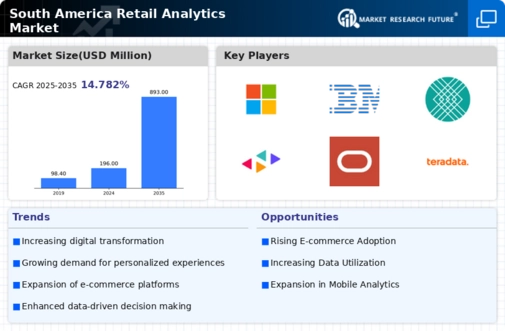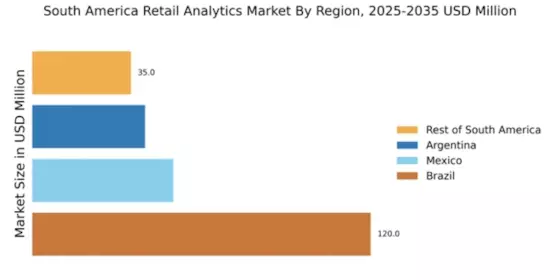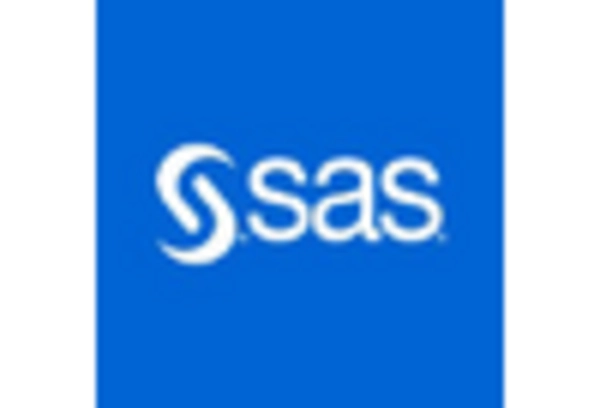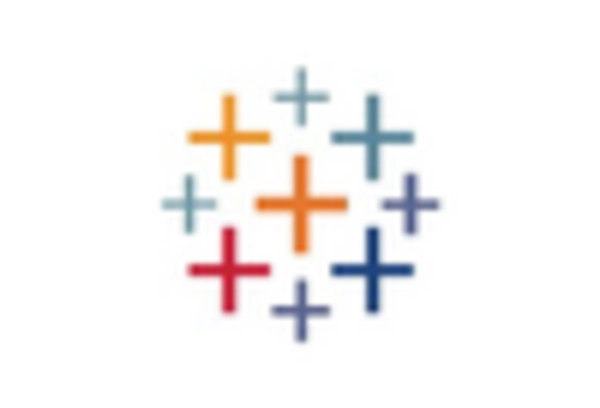Growing E-Commerce Adoption
The retail analytics market in South America is experiencing a notable surge due to the increasing adoption of e-commerce platforms. As consumers increasingly prefer online shopping, retailers are compelled to leverage analytics to understand consumer behavior and preferences. In 2025, e-commerce sales in South America are projected to reach around $100 billion, indicating a robust growth trajectory. Retailers are utilizing analytics to optimize their online offerings, enhance customer experiences, and streamline supply chains. This trend is likely to drive demand for advanced analytics solutions, as businesses seek to gain insights into customer journeys and improve conversion rates. Consequently, the growing e-commerce adoption is a pivotal driver for the retail analytics market in the region.
Rising Competition Among Retailers
The competitive landscape in South America's retail sector is intensifying, prompting businesses to adopt retail analytics to gain a competitive edge. With numerous players vying for market share, retailers are increasingly relying on data-driven strategies to enhance operational efficiency and customer engagement. The retail analytics market is projected to grow at a CAGR of 15% from 2025 to 2030, driven by the need for retailers to differentiate themselves. By leveraging analytics, businesses can identify market trends, optimize pricing strategies, and tailor marketing campaigns to specific customer segments. This heightened competition is likely to propel the adoption of retail analytics solutions, as companies strive to make informed decisions and improve their market positioning.
Integration of Omnichannel Strategies
The integration of omnichannel strategies is reshaping the retail landscape in South America and impacting the retail analytics market. Retailers are increasingly adopting a seamless approach to connect online and offline channels, necessitating the use of analytics to track customer interactions across various touchpoints. In 2025, it is estimated that omnichannel customers will spend 30% more than single-channel customers, highlighting the importance of a cohesive shopping experience. Retail analytics enables businesses to analyze customer behavior across channels, optimize inventory management, and enhance marketing efforts. This trend underscores the necessity for retailers to invest in analytics solutions that facilitate a comprehensive understanding of customer journeys, making omnichannel integration a significant driver for the retail analytics market.
Demand for Personalized Shopping Experiences
In South America, consumers are increasingly seeking personalized shopping experiences, which is significantly influencing the retail analytics market. Retailers are utilizing analytics to gather customer data, enabling them to offer tailored recommendations and promotions. This trend is evident as studies indicate that 80% of consumers are more likely to make a purchase when brands offer personalized experiences. As a result, businesses are investing in retail analytics tools to enhance customer engagement and loyalty. The ability to understand individual preferences and behaviors is becoming crucial for retailers aiming to foster long-term relationships with their customers. Thus, the demand for personalized shopping experiences is a key driver for the retail analytics market in the region.
Regulatory Compliance and Data Privacy Concerns
As the retail sector in South America evolves, regulatory compliance and data privacy concerns are becoming increasingly prominent, influencing the retail analytics market. Retailers must navigate complex regulations regarding data protection, which necessitates the implementation of robust analytics solutions to ensure compliance. In 2025, it is anticipated that 60% of retailers will prioritize data privacy in their analytics strategies. This focus on compliance not only protects consumer data but also enhances brand trust and loyalty. Consequently, the demand for analytics tools that incorporate data governance and security features is likely to rise, positioning regulatory compliance as a critical driver for the retail analytics market in the region.


















Leave a Comment